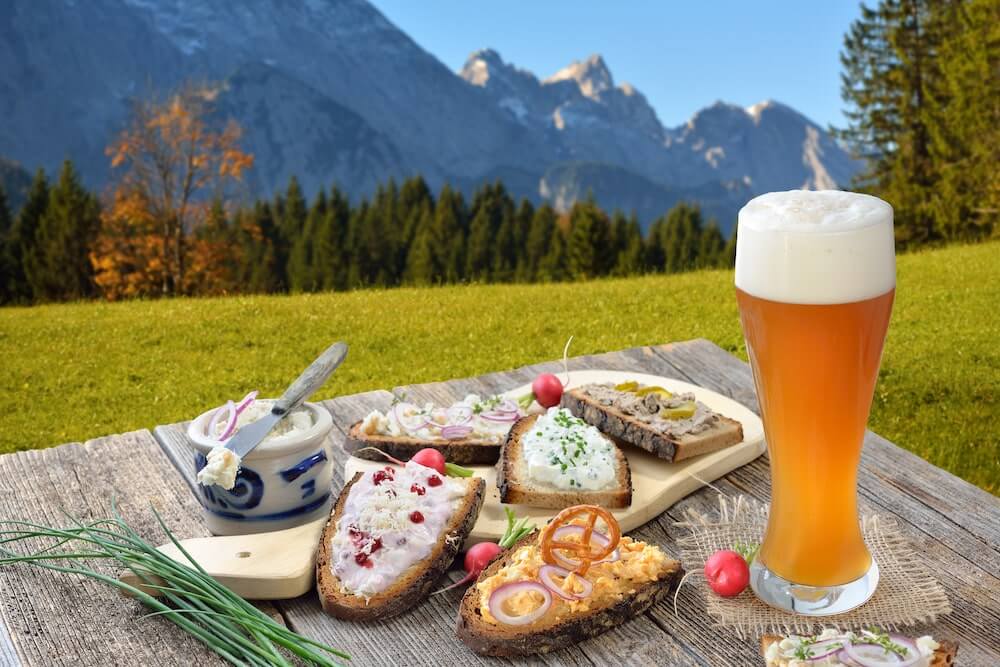
Food and Drink Pairings: Our Favorites from the Alps
To celebrate spring, Ryder-Walker wants to invite you to try our favorite springtime recipes from the Alps. Across Northern Italy, Switzerland, and France much of the cooking is associated with heavy dishes best enjoyed in the heart of winter. The traditional recipes that define alpine cuisine typically involve a huge amount of cheese and meat: hearty fare that is representative of the demanding living that was once ubiquitous in the high mountains. Of course, these recipes have been refined and specialized into the delicious variations we know today, but what of the (slightly) lighter dishes available throughout the Alps that are best enjoyed as the weather gets warmer?

Charcuterie
There is little better way to kick off the springtime than inviting a group of friends over to enjoy a full charcuterie board. This meat, cheese, and bread plate is all about the presentation and quality of ingredients. A variety of quality cheese and air-dried meats is a must, with a recommendation towards including thin-cut meats such as Bundnerfleisch or Prosciutto, while hard cheeses are often well received as a compliment. Outside of core meats and cheeses, no charcuterie is complete without its complements: dried fruits, nuts, olives, and gherkins are all an excellent direction to lean.
Pairing: Chignon Bergeron
Chignon Bergeron is the most iconic white wine from the Savoie region of Southeastern France – the alpine region surrounding Chamonix, and thus it is a fitting pairing for charcuterie, but truly you can choose whatever your favorite grape or vintage is – there is nothing quite like wine and cheese to get the party started.
Recipe
- Cured meats: Prosciutto, Speck, or Soppressata
- Cheeses: Gruyère, Comté, aged Emmental, or a young Alpine Tomme
- Bread: Rustic baguette slices, crisp flatbreads, or seeded crackers
- Accents:
- Cornichons or gherkins
- Castelvetrano or Niçoise olives
- Dried apricots, figs, or cherries
- Roasted almonds or walnuts
- Grainy mustard or fruit preserves (like fig or cherry)
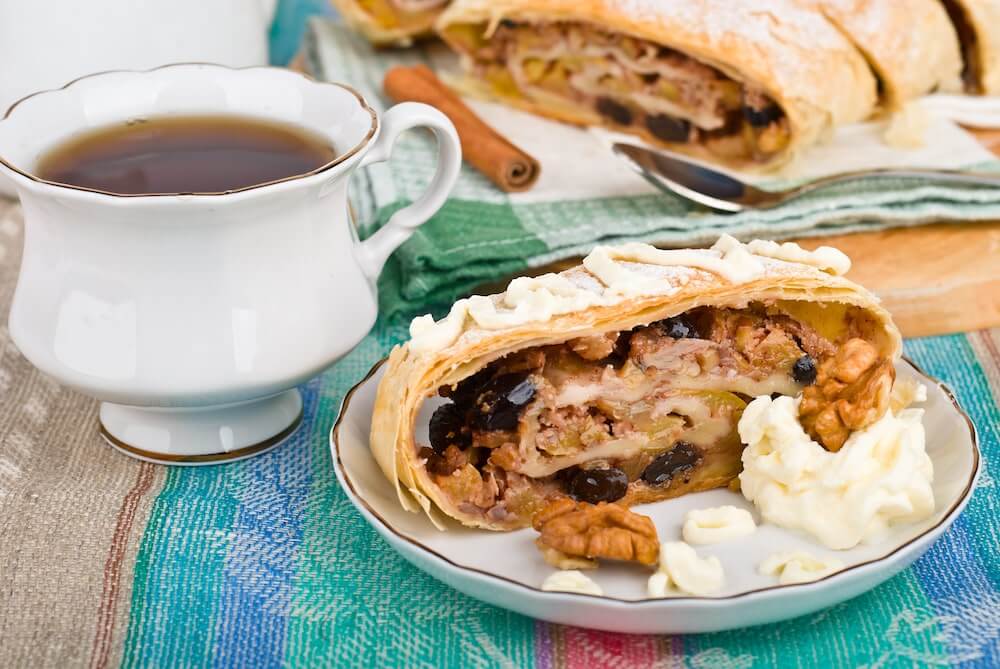
Apfelstrudel
Apfelstrudel is a truly delightful apple pastry found across Germany and the Austrian Tyrol. Apfelstrudel starts with a flaky puff pastry which is then layered with apples that have been marinated in sugar, cinnamon, and a squeeze of lemon. Top your pastry with either vanilla sauce or a dollop of sweet cream for one of the most excellent pastry experiences you can have anywhere in Europe.
Pairing: Milchkaffee
Milchkaffee is the German word for coffee with milk, the ideal accompaniment for a morning apfelstrudel. German coffee, while less lauded than Italian coffee, is a surprisingly delicious product, exemplifying the region’s propensity towards excellence in all its products.
Recipe
Ingredients:
- 6 tart apples (such as Granny Smith), peeled, cored, and thinly sliced
- 1/2 cup sugar
- 1 tsp cinnamon
- 1 tbsp lemon juice
- 1/2 cup raisins (optional)
- 1/2 cup chopped walnuts or almonds (optional)
- 8 sheets phyllo dough or puff pastry
- 1/4 cup melted butter
- Powdered sugar, for dusting
Instructions:
- Preheat oven to 375°F (190°C).
- In a large bowl, toss sliced apples with sugar, cinnamon, lemon juice, and optional raisins and nuts. Let sit for 10–15 minutes to allow flavors to meld.
- If using phyllo dough, lay one sheet on a clean towel and brush lightly with melted butter. Layer with additional sheets, buttering each one as you go.
- Spoon the apple mixture along one side of the dough, leaving a 2-inch border. Carefully roll the dough over the filling using the towel to help guide it, tucking in the sides as you roll.
- Place the strudel seam-side down on a parchment-lined baking sheet. Brush with remaining butter.
- Bake for 35–40 minutes, or until golden brown and crisp.
- Let cool slightly, dust with powdered sugar, and serve warm with vanilla sauce or whipped cream.

Asparagus Risotto
A springtime favorite in the Alpine regions of Northern Italy, Asparagus Risotto is a creamy, comforting dish that celebrates the arrival of the season’s earliest produce. The fresh, grassy flavor of asparagus pairs beautifully with the richness of risotto, making this a perfect main or side dish for your next spring gathering.
Pairing: Apremont
Enjoy this white wine from the Savoie region with floral and mineral notes that perfectly complements the fresh asparagus and creamy risotto.
Recipe
Ingredients:
- 1 bunch of fresh asparagus, trimmed and cut into 1-inch pieces
- 1 tablespoon olive oil
- 1 small onion or shallot, finely chopped
- 1 cup Arborio rice
- ½ cup dry white wine
- 4 cups vegetable or chicken stock, kept warm
- ½ cup grated Parmesan cheese
- 2 tablespoons butter
- Salt and pepper, to taste
- Zest of 1 lemon (optional for brightness)
Instructions:
- Blanch the asparagus: Bring a pot of salted water to a boil. Blanch the asparagus for 2–3 minutes, until bright green and just tender. Drain and set aside.
- Sauté aromatics: In a large sauté pan or saucepan, heat olive oil over medium heat. Add the onion or shallot and cook until translucent.
- Toast the rice: Add the Arborio rice to the pan and cook, stirring, for 1–2 minutes until the grains are lightly toasted.
- Deglaze and simmer: Pour in the white wine and stir until absorbed. Begin adding the warm stock, one ladle at a time, stirring frequently. Allow each addition to absorb before adding more. Continue until the rice is al dente and creamy, about 18–20 minutes.
- Finish the dish: Stir in the blanched asparagus, Parmesan cheese, butter, and lemon zest if using. Season to taste with salt and pepper.
- Serve: Spoon into bowls and enjoy immediately with a glass of chilled Apremont and a view of the springtime Alps.
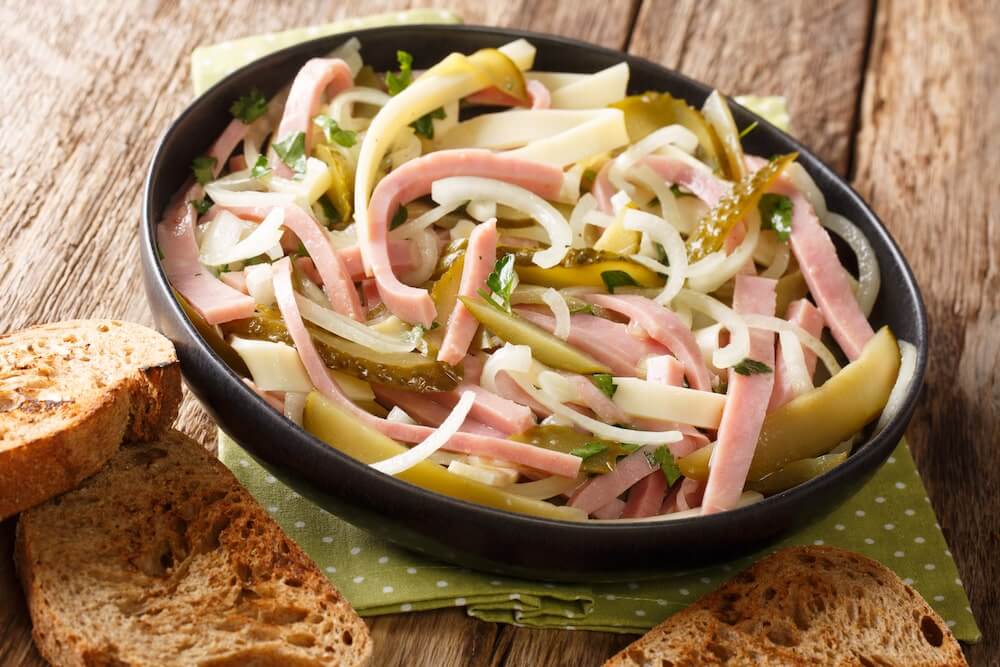
Bergsalat
Bergsalat or mountain salad is a less-sung dish in the Swiss Alps that is truly delicious. In Switzerland, salads are often eaten as an entire meal rather than as an appetizer or side dish, and the ingredient list is reflective of this. The first and most distinct element here is the inclusion of both meat and cheese in the salad – how incredibly Swiss. The cheese is typically ultra-sharp and hard, cut extremely thinly so it curls, followed by similarly thin-cut cured meat. To make a true Swiss salad you need a large bounty of vegetables as well, shredded carrots marinated in vinegar are an iconic addition, as are shredded beats, sliced radishes, mixed greens, and sometimes even green beans or corn. Another more surprising addition to the Swiss salad is a side of tuna!
Pairing: Rivella
There may be nothing more Swiss than Rivella. This unique soda comes in a bottle adorned with the Swiss flag; in case you were in any doubt about its national origin. Made from milk curd, Rivella is sweetened with mountain herbs and sugar.
Recipe
Ingredients:
- Mixed spring greens (arugula, lettuce, mâche)
- 1 carrot, shredded and marinated in white wine vinegar
- 1 small beet, shredded or julienned
- 4–6 radishes, thinly sliced
- ½ cup blanched green beans or sweet corn (optional)
- 2 oz sharp Alpine cheese (like Sbrinz or aged Gruyère), shaved into curls
- 2 oz Bündnerfleisch, Prosciutto, or other air-dried meat, thinly sliced
- 2–3 oz high-quality canned tuna (served on the side or flaked over top)
- 2 tbsp roasted sunflower seeds or crushed walnuts (optional)
For the Dressing:
- 2 tbsp white wine vinegar
- 1 tsp Dijon mustard
- ¼ tsp salt
- Freshly ground pepper
- 4 tbsp sunflower oil or olive oil
Instructions:
- Marinate the carrots: Toss shredded carrots with a splash of white wine vinegar and a pinch of salt. Let sit for 10–15 minutes.
- Make the dressing: Whisk together vinegar, mustard, salt, and pepper. Slowly whisk in the oil until well emulsified.
- Assemble the salad: On a large plate or shallow bowl, arrange a bed of mixed greens. Add mounds of marinated carrots, shredded beets, radishes, green beans or corn, and tuna.
- Top it off: Add curls of cheese and slices of cured meat across the top. Sprinkle with seeds or nuts if using.
- Drizzle & serve: Finish with the dressing and serve immediately with rustic bread and a glass of chilled white wine.
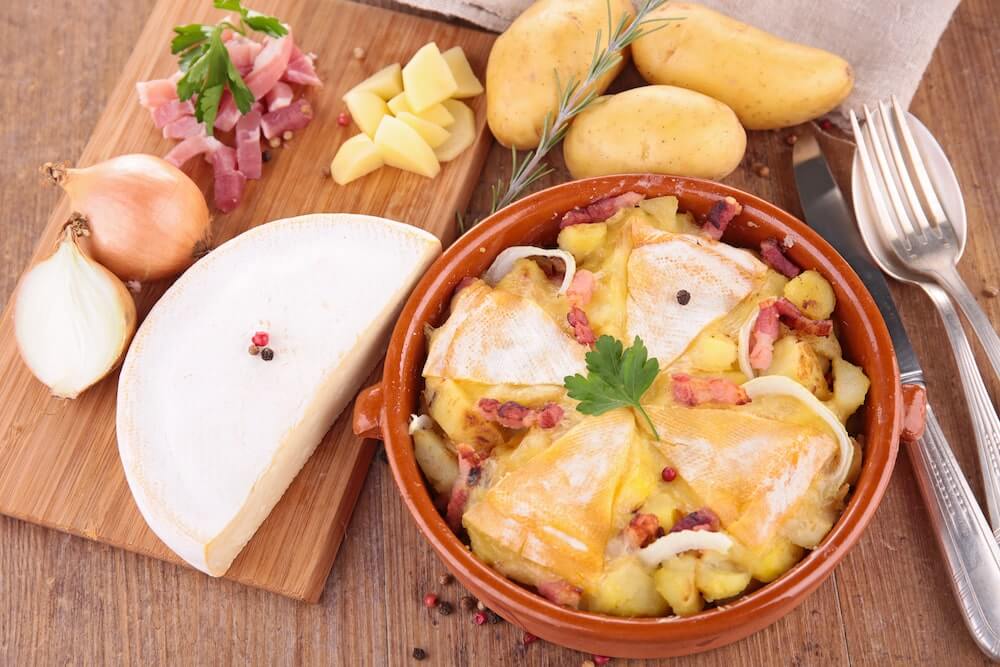
Tartiflette
While calling the tartiflette a “lighter” dish is a bit of a stretch, it is hard to put together any list of alpine food without including the queen of cheese dishes. The tartiflette is a truly unique Savoyard casserole. Begin making your tartiflette by boiling potatoes until they are beginning to soften but are short of being entirely edible. Arrange the thinly sliced potatoes in a cast iron pan, cover them in Reblochon cheese, add ham or bacon, and then douse the entire dish in cream and a splash of white wine. The tartiflette is then baked until the potatoes are cooked through and beginning to crisp around the edges.
Pairing: White Wine
The cardinal rule when eating a cheese-heavy alpine dish is to drink white wine alongside it. Drinking beer with a tartiflette is often a recipe for a digestive nightmare, while the chemical makeup of white wine allows your body to digest the cheese-bomb more smoothly – this reaction is the same reason that white wine is used to emulsify fondue.
Recipe
Ingredients:
- 2 lbs waxy potatoes (Yukon Gold or similar)
- 1 medium onion, thinly sliced
- 6 oz diced bacon or lardons
- 1 whole Reblochon cheese (about 450g), halved horizontally
- ½ cup crème fraîche or heavy cream
- ¼ cup dry white wine
- Salt and pepper to taste
- Butter, for greasing the pan
Instructions:
- Prepare the potatoes: Boil whole potatoes in salted water until just tender, about 15–20 minutes. Drain, let cool slightly, then peel and slice into ¼-inch rounds.
- Cook the bacon and onion: In a skillet, cook the diced bacon over medium heat until starting to brown. Add onions and cook until soft and golden, about 10 minutes. Set aside.
- Assemble the tartiflette: Preheat the oven to 375°F (190°C). Butter a cast iron skillet or baking dish. Layer in half the potatoes, followed by half of the bacon and onion mixture. Repeat the layers, then pour the cream and white wine over the top.
- Top with cheese: Place the halved Reblochon cheese, rind-side up, over the top of the casserole.
- Bake: Bake for 25–30 minutes, or until the cheese is bubbling and the top is golden. Let rest for a few minutes before serving.
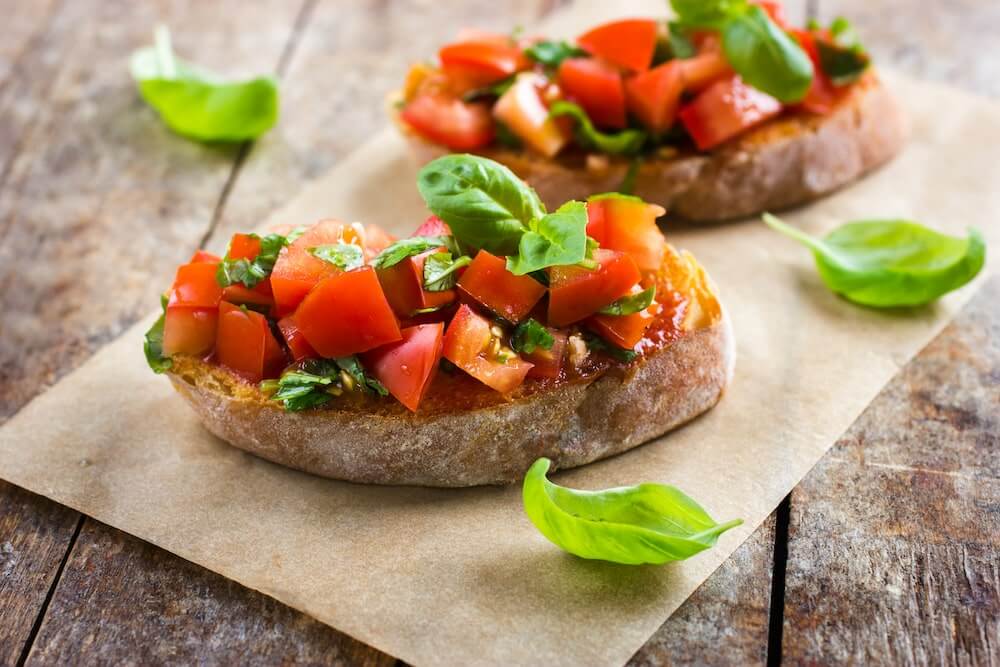
Bruschetta
Looking towards northern Italy, Bruschetta is the perfect dish to ring in spring. This simple fare starts with grilled bread, which is then topped with olive oil, salt, vinegar, and diced tomatoes. Simple, fresh, and delightful.
Pairing: Aperol Spritz
A snack as light and delicate as Bruschetta needs an equally summery pairing and what better addition than the joyous Aperol Spritz? This carbonated drink has recently exploded across U.S. cocktail culture and is an easy one to make – just combine Aperol, bubbly, seltzer, and a slice of orange.
Recipe
Ingredients:
- 1 baguette or rustic country loaf, sliced ½ inch thick
- 2 cups ripe cherry tomatoes, finely diced
- 2 cloves garlic (1 whole, 1 minced)
- 2 tbsp extra virgin olive oil, plus more for drizzling
- 1 tbsp balsamic vinegar
- Sea salt and freshly ground black pepper, to taste
- Fresh basil, finely chopped
Instructions:
- Prepare the tomato topping: In a bowl, combine diced tomatoes, minced garlic, olive oil, balsamic vinegar, and salt and pepper to taste. Let sit for 15–20 minutes to allow the flavors to meld.
- Grill the bread: Lightly brush each slice of bread with olive oil. Grill or toast until golden and crisp. While still warm, rub the cut side of a peeled garlic clove over each slice for a subtle depth of flavor.
- Assemble the bruschetta: Spoon the marinated tomato mixture generously over the grilled bread. Top with chopped basil if desired, and finish with a light drizzle of olive oil.

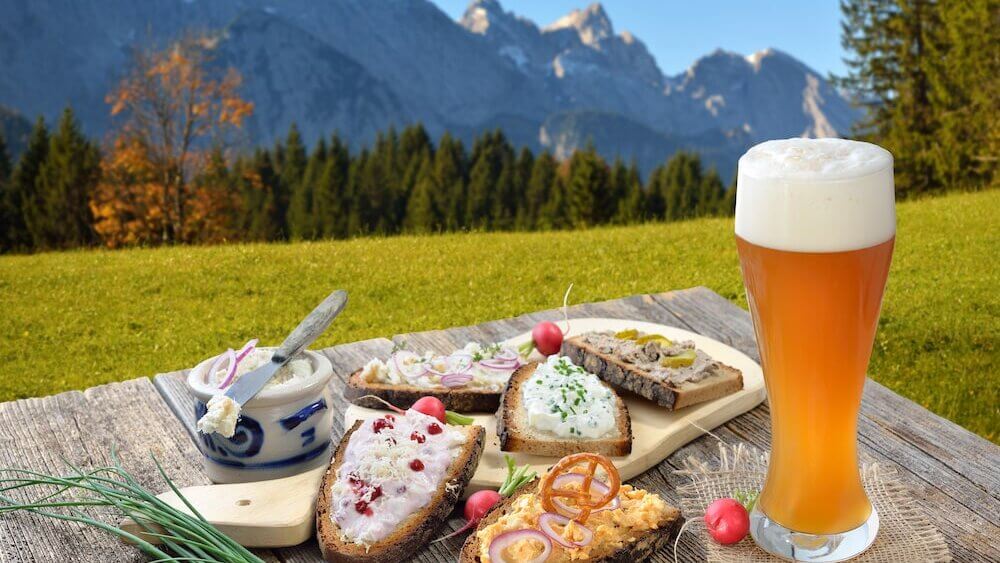



















Comments are closed.